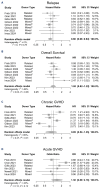Clinical impact of clonal hematopoiesis in hematopoietic cell transplantation: a review, meta-analysis, and call to action
- PMID: 38899345
- PMCID: PMC11609801
- DOI: 10.3324/haematol.2024.285392
Clinical impact of clonal hematopoiesis in hematopoietic cell transplantation: a review, meta-analysis, and call to action
Abstract
Hematopoietic cell transplantation (HCT) is the only potentially curative treatment option for many patients with hematologic malignancies. While HCT outcomes have improved drastically over the years, patients and clinicians continue to face numerous survivorship challenges, such as relapse, graft-versus-host disease, and secondary malignancies. Recent literature suggests that clonal hematopoiesis (CH), the presence of a recurrent somatic mutation in hematopoietic cells, in HCT patients or donors may be associated with outcomes in autologous and allogeneic HCT. Herein, we perform a review of the literature and summarize reported associations between CH and clinical outcomes in HCT. For commonly reported outcomes, we used meta-analysis methods to provide estimates of effect sizes when combining results. A total of 32 articles with relevant and independent contributions were included, covering both autologous (N=19) and allogeneic (N=13) HCT. The articles report variable risk for developing outcomes according to CH characteristics, patient disease status, and method of HCT. Using meta-analysis of available results, HCT outcomes with statistically significant effects by CH status include therapy-related myeloid neoplasms (odds ratio =3.65; 95% confidence interval [CI]: 2.18-6.10) and overall survival (hazard ratio [HR]=1.38; 95% CI: 1.20-1.58) in autologous HCT and relapse (HR=0.80; 95% CI: 0.68-0.94) in allogeneic HCT. However, heterogeneity, biases, and limitations in the literature provide challenges for informing the translation of CH to clinical decision- making. We conclude with a call to action and discussion of next steps to build upon the current literature and provide granularity to the true clinical impact of CH in the setting of HCT.
Figures




References
-
- Hashmi SK, Lee SJ, Savani BN, et al. . ASBMT Practice Guidelines Committee survey on long-term follow-up clinics for hematopoietic cell transplant survivors. Biol Blood Marrow Transplant. 2018;24(6):1119-1124. - PubMed
Publication types
MeSH terms
Grants and funding
LinkOut - more resources
Full Text Sources
Miscellaneous

